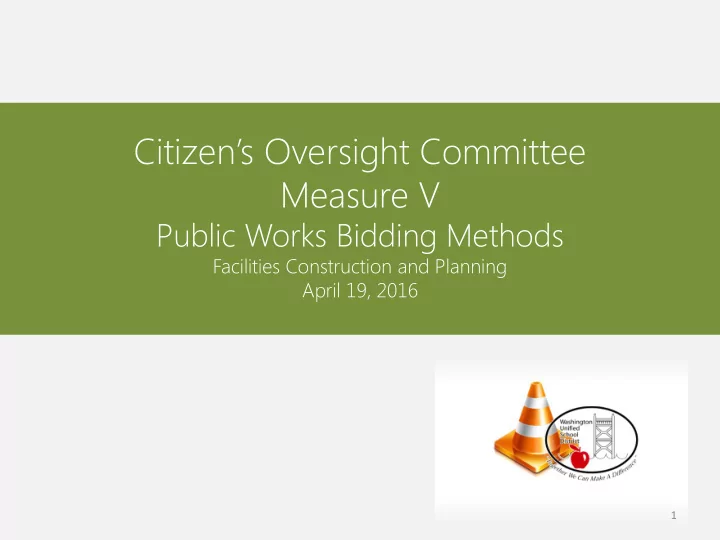

Citizen’s Oversight Committee Measure V Public Works Bidding Methods Facilities Construction and Planning April 19, 2016 1
Public Works Bidding Process 1 st : Identify the need What is the scope of the project? What is the budget? Who are the necessary team members? i.e. contractors, consultants, inspectors… All aspects of “the need” tailor the bidding process 2
Commonly Practiced Public Works Bidding Options California Uniform Construction Cost Accounting Act (CUPCCAA) The Base-Line Lowest Responsive Bidder (Hard Bid) Lease/Lease-Back Design-Bid-Build and Design Build 3
How to Select Optimum Bidding Process Identify the need What type of support team do we need? -Is it a DSA project? -Do we need a specialist, inspector, special testing, etc.? What is the budget? Certain bidding methods are only acceptable when pertaining to specific dollar figures Establish a timeline Some bidding methods are immediate, while others can take months 4
CUPCCAA Bidding Process Projects $175,000 and under Contractors and service providers submit applications for preapproval Notify specialty contractors and vendors on CUPCCAA preapproved list so that each may attend a bid walk and submit their bid Sort by Specialties Quick reference; often used to remedy sudden and urgent matters Lowest responsive bidder that is able to meet District requirements is awarded contract 5
Base-Line Lowest: Hard Bid Bidding Process Prepare for and advertise months before construction start date Advertise in local paper and alert firms/companies from prequalified list Most competitive bidding system Contractors are subject to a large competitive pool; encourages contractor to submit lowest possible bid Lowest responsive bid is awarded contract Works in District’s advantage to lock in potentially lower rates when contractor is submitting during optimum bidding climate (Winter) If there are alterations to original proposal (Change Order), District pays the difference 6
Lease/Lease Back District gets to hand select contractors from preapproved list Contingencies and Allowances instead of Change Orders Guaranteed Max Price District pays the same rate even if unforeseen conditions arise Contractor assumes risk Contractor is allowed to “value engineer” architect’s original design if different materials are more readily available or design features can be altered for more efficiency 7
Preapproved List for Projects Over 1 Million as Required by California Assembly Bill (AB) 1565 8
Design Build & Design-Bid-Build Design Build Design-Bid-Build District designates architect who District selects all project team then selects all subcontractors players Minimizes risk to district as design District is very involved throughout team and subcontractors are entire process and will be responsible for all costs including financially responsible for all work unforeseen costs on project Overlapping design and Design comes first, then construction phase contractors bid on project Can be cheaper and faster, but District involved in all decision District is less involved in decision making; the design and outcome making are more customized to suit District needs 9
Who Participates in Competitive Bidding and Their Roles Contractors Physically build the architects’ plans Architects Design the plans and work closely with entire team and Department of State Architects (DSA) Testing Labs Perform testing on soils, environmental, and structural support Inspectors Monitor and report DSA requirements directly to entire team Specialty Consultants Specialize in specific project genres to offer expertise in support of the District (Solar) 10
Contract Award Process Issue Request for Proposal (RFP) Paper screen all proposals Formal presentation and interviews Select firm/company for services Present proposal to Board of Education for approval Award contract to selected firm/company 11
Request for Proposal (RFP) Step 1 Issue RFP District Website Notify West Sacramento Chamber of Commerce Plan Wells - A contractors’ networking system Public Advertisement Issue minimum of 2 public advertisements (Sac Bee) Mandatory Pre-Bid Walk District walks the job site to discuss project details required of proposal Specific instructions are provided so that review of proposal will be precise and efficient Failure to include District requirements presented in RFP and Pre-Bid Walk will result in disqualification 12
Paper Screening Step 2 All proposals are subject to paper screening (i.e. following directions) Committee reviews proposals to verify that requirements are met by responsive firm/company All costs, inclusions, and omissions are noted for future questioning Only proposals meeting all requirements, including budget, are invited to present to committee 13
Formal Presentations and Interviews Step 3 Firm/company presents proposal Committee has opportunity to address any questions Each committee member rates the proposals with a point system The firm/company with the lowest responsive quote and the highest ranking points is presented to the Board of Education for approval 14
The RFP Process Eliminates favoritism and bias Keeps the market competitive Helps the District select from a large pool of firms/contractors Industry standard to issue RFPs every 3 years for various professional service providers (i.e. architects, and consultants) to compile District Team. This creates the ability to make selections for various projects over the course of subsequent years 15
Each Method Serves a Purpose District’s Needs, Budget and Time Frame Using a variety of methods allows the District to find Support Team Architect the perfect Members solution for each project Contractor The number one priority of each project is always serving our students. Each method offers a different manner in which we can better meet the variety of their needs. 16
Recommend
More recommend